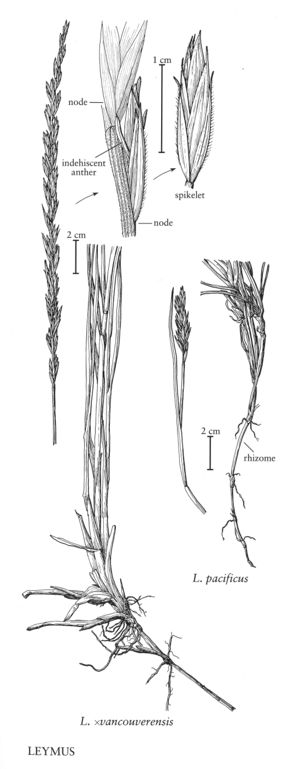Difference between revisions of "Leymus pacificus"
FNA>Volume Importer |
imported>Volume Importer |
||
| (4 intermediate revisions by 2 users not shown) | |||
| Line 4: | Line 4: | ||
|publications= | |publications= | ||
|common_names=Pacific wildrye | |common_names=Pacific wildrye | ||
| + | |special_status={{Treatment/ID/Special_status | ||
| + | |code=E | ||
| + | |label=Endemic | ||
| + | }} | ||
|basionyms= | |basionyms= | ||
|synonyms={{Treatment/ID/Synonym | |synonyms={{Treatment/ID/Synonym | ||
|name=Elymus pacificus | |name=Elymus pacificus | ||
| − | |authority= | + | |authority= |
| + | |rank=species | ||
}} {{Treatment/ID/Synonym | }} {{Treatment/ID/Synonym | ||
|name=Agropyron arenicola | |name=Agropyron arenicola | ||
| − | |authority= | + | |authority= |
| + | |rank=species | ||
}} | }} | ||
|hierarchy=Poaceae;Poaceae subfam. Pooideae;Poaceae tribe Triticeae;Leymus;Leymus pacificus | |hierarchy=Poaceae;Poaceae subfam. Pooideae;Poaceae tribe Triticeae;Leymus;Leymus pacificus | ||
| Line 23: | Line 29: | ||
-->{{Treatment/Body | -->{{Treatment/Body | ||
|distribution=Calif. | |distribution=Calif. | ||
| − | |discussion=<p>Leymus pacificus is found on coastal bluffs from Mendocino to Santa Barbara counties, California. It is poorly represented in herbaria. In some years it grows almost entirely vegetatively, often being represented by scattered innovations with somewhat curved leaves.</p> | + | |discussion=<p><i>Leymus pacificus</i> is found on coastal bluffs from Mendocino to Santa Barbara counties, California. It is poorly represented in herbaria. In some years it grows almost entirely vegetatively, often being represented by scattered innovations with somewhat curved leaves.</p> |
|tables= | |tables= | ||
|references= | |references= | ||
| Line 32: | Line 38: | ||
-->{{#Taxon: | -->{{#Taxon: | ||
name=Leymus pacificus | name=Leymus pacificus | ||
| − | |||
|authority=(Gould) D.R. Dewey | |authority=(Gould) D.R. Dewey | ||
|rank=species | |rank=species | ||
| Line 40: | Line 45: | ||
|family=Poaceae | |family=Poaceae | ||
|illustrator=Cindy Roché | |illustrator=Cindy Roché | ||
| + | |illustration copyright=Utah State University | ||
|distribution=Calif. | |distribution=Calif. | ||
|reference=None | |reference=None | ||
|publication title= | |publication title= | ||
|publication year= | |publication year= | ||
| − | |special status= | + | |special status=Endemic |
| − | |source xml=https:// | + | |source xml=https://bitbucket.org/aafc-mbb/fna-data-curation/src/200273ad09963decb8fc72550212de541d86569d/coarse_grained_fna_xml/V24/V24_512.xml |
|subfamily=Poaceae subfam. Pooideae | |subfamily=Poaceae subfam. Pooideae | ||
|tribe=Poaceae tribe Triticeae | |tribe=Poaceae tribe Triticeae | ||
Latest revision as of 17:24, 11 May 2021
Plants not cespitose, strongly rhizomatous. Culms 10-30(60) cm tall, 1-2 mm thick, solitary or few together, glabrous or sparsely pubescent near the nodes. Leaves equaling or exceeding the spikes; sheaths glabrous; auricles to 1.4 mm; ligules 0.2-0.3 mm, truncate, erose; blades 10-30 cm long, 2-A mm wide, abaxial surfaces glabrous, adaxial surfaces scabrous, veins about 15, subequal, prominently ribbed. Spikes 2-8 cm long, 7-12 mm wide, with 1-2 spikelets per node; internodes 3.5-4 mm, surfaces glabrous and smooth, edges weakly scabrous distally. Spikelets 12-15 mm, with 4-6 florets. Glumes subequal, (5)7-15 mm long, 0.5-2.5 mm wide, narrowly lanceolate, tapering from near the base, stiff, keeled, the central portion thicker than the margins, bases mostly glabrous, margins ciliate, 1-3(5)-veined, veins inconspicuous at midlength; calluses scarcely developed, glabrous; lemmas 7-11 mm, glabrous, smooth, apices acute to awn-tipped, awns to 0.8 mm; anthers 3-4 mm, dehiscent. 2n = 28.
Discussion
Leymus pacificus is found on coastal bluffs from Mendocino to Santa Barbara counties, California. It is poorly represented in herbaria. In some years it grows almost entirely vegetatively, often being represented by scattered innovations with somewhat curved leaves.
Selected References
None.
